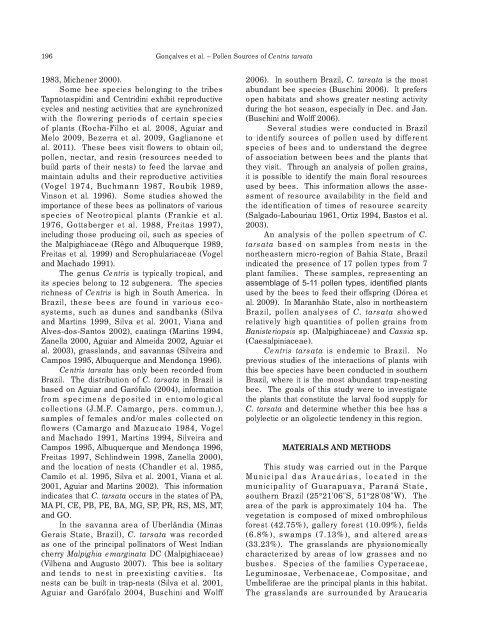Download PDF - Zoological Studies - Academia Sinica
Download PDF - Zoological Studies - Academia Sinica
Download PDF - Zoological Studies - Academia Sinica
You also want an ePaper? Increase the reach of your titles
YUMPU automatically turns print PDFs into web optimized ePapers that Google loves.
196<br />
Gonçalves et al. – Pollen Sources of Centris tarsata<br />
1983, Michener 2000).<br />
Some bee species belonging to the tribes<br />
Tapnotaspidini and Centridini exhibit reproductive<br />
cycles and nesting activities that are synchronized<br />
with the flowering periods of certain species<br />
of plants (Rocha-Filho et al. 2008, Aguiar and<br />
Melo 2009, Bezerra et al. 2009, Gaglianone et<br />
al. 2011). These bees visit flowers to obtain oil,<br />
pollen, nectar, and resin (resources needed to<br />
build parts of their nests) to feed the larvae and<br />
maintain adults and their reproductive activities<br />
(Vogel 1974, Buchmann 1987, Roubik 1989,<br />
Vinson et al. 1996). Some studies showed the<br />
importance of these bees as pollinators of various<br />
species of Neotropical plants (Frankie et al.<br />
1976, Gottsberger et al. 1988, Freitas 1997),<br />
including those producing oil, such as species of<br />
the Malpighiaceae (Rêgo and Albuquerque 1989,<br />
Freitas et al. 1999) and Scrophulariaceae (Vogel<br />
and Machado 1991).<br />
The genus Centris is typically tropical, and<br />
its species belong to 12 subgenera. The species<br />
richness of Centris is high in South America. In<br />
Brazil, these bees are found in various ecosystems,<br />
such as dunes and sandbanks (Silva<br />
and Martins 1999, Silva et al. 2001, Viana and<br />
Alves-dos-Santos 2002), caatinga (Martins 1994,<br />
Zanella 2000, Aguiar and Almeida 2002, Aguiar et<br />
al. 2003), grasslands, and savannas (Silveira and<br />
Campos 1995, Albuquerque and Mendonça 1996).<br />
Centris tarsata has only been recorded from<br />
Brazil. The distribution of C. tarsata in Brazil is<br />
based on Aguiar and Garófalo (2004), information<br />
from specimens deposited in entomological<br />
collections (J.M.F. Camargo, pers. commun.),<br />
samples of females and/or males collected on<br />
flowers (Camargo and Mazucato 1984, Vogel<br />
and Machado 1991, Martins 1994, Silveira and<br />
Campos 1995, Albuquerque and Mendonça 1996,<br />
Freitas 1997, Schlindwein 1998, Zanella 2000),<br />
and the location of nests (Chandler et al. 1985,<br />
Camilo et al. 1995, Silva et al. 2001, Viana et al.<br />
2001, Aguiar and Martins 2002). This information<br />
indicates that C. tarsata occurs in the states of PA,<br />
MA PI, CE, PB, PE, BA, MG, SP, PR, RS, MS, MT,<br />
and GO.<br />
In the savanna area of Uberlândia (Minas<br />
Gerais State, Brazil), C. tarsata was recorded<br />
as one of the principal pollinators of West Indian<br />
cherry Malpighia emarginata DC (Malpighiaceae)<br />
(Vilhena and Augusto 2007). This bee is solitary<br />
and tends to nest in preexisting cavities. Its<br />
nests can be built in trap-nests (Silva et al. 2001,<br />
Aguiar and Garófalo 2004, Buschini and Wolff<br />
2006). In southern Brazil, C. tarsata is the most<br />
abundant bee species (Buschini 2006). It prefers<br />
open habitats and shows greater nesting activity<br />
during the hot season, especially in Dec. and Jan.<br />
(Buschini and Wolff 2006).<br />
Several studies were conducted in Brazil<br />
to identify sources of pollen used by different<br />
species of bees and to understand the degree<br />
of association between bees and the plants that<br />
they visit. Through an analysis of pollen grains,<br />
it is possible to identify the main floral resources<br />
used by bees. This information allows the assessment<br />
of resource availability in the field and<br />
the identification of times of resource scarcity<br />
(Salgado-Labouriau 1961, Ortiz 1994, Bastos et al.<br />
2003).<br />
An analysis of the pollen spectrum of C.<br />
tarsata based on samples from nests in the<br />
northeastern micro-region of Bahia State, Brazil<br />
indicated the presence of 17 pollen types from 7<br />
plant families. These samples, representing an<br />
assemblage of 5-11 pollen types, identified plants<br />
used by the bees to feed their offspring (Dórea et<br />
al. 2009). In Maranhão State, also in northeastern<br />
Brazil, pollen analyses of C. tarsata showed<br />
relatively high quantities of pollen grains from<br />
Banisteriopsis sp. (Malpighiaceae) and Cassia sp.<br />
(Caesalpiniaceae).<br />
Centris tarsata is endemic to Brazil. No<br />
previous studies of the interactions of plants with<br />
this bee species have been conducted in southern<br />
Brazil, where it is the most abundant trap-nesting<br />
bee. The goals of this study were to investigate<br />
the plants that constitute the larval food supply for<br />
C. tarsata and determine whether this bee has a<br />
polylectic or an oligolectic tendency in this region.<br />
MATERIALS AND METHODS<br />
This study was carried out in the Parque<br />
Municipal das Araucárias, located in the<br />
municipality of Guarapuava, Paraná State,<br />
southern Brazil (25°21'06"S, 51°28'08"W). The<br />
area of the park is approximately 104 ha. The<br />
vegetation is composed of mixed ombrophilous<br />
forest (42.75%), gallery forest (10.09%), fields<br />
(6.8%), swamps (7.13%), and altered areas<br />
(33.23%). The grasslands are physionomically<br />
characterized by areas of low grasses and no<br />
bushes. Species of the families Cyperaceae,<br />
Leguminosae, Verbenaceae, Compositae, and<br />
Umbelliferae are the principal plants in this habitat.<br />
The grasslands are surrounded by Araucaria

















